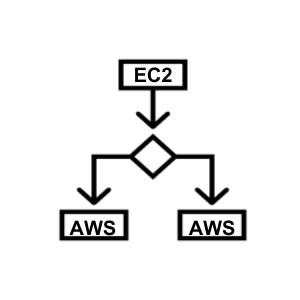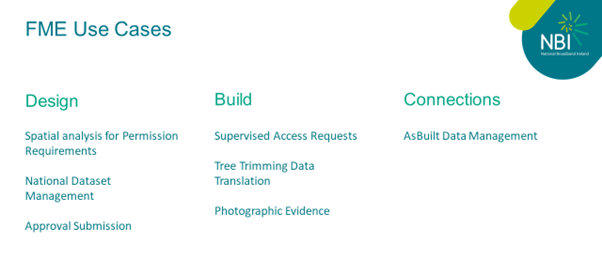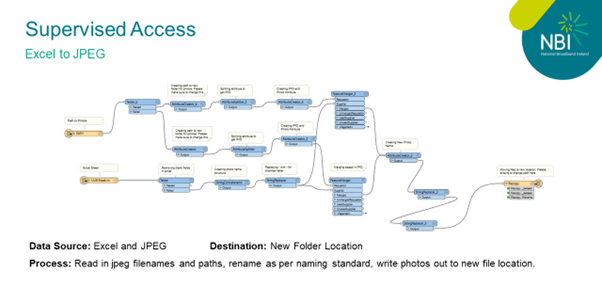- FME Integration
- FME Form
- FME Flow
- FME Flow Hosted
- FME Services
- GIS
- M.App Enterprise
- GeoMedia Desktop
- HxGN Networks
- Remote Sensing
- ERDAS Imagine
- Support Services
- Training Services

Utilising FME At National Broadband Ireland
National Broadband Ireland (NBI) are contracted by the Department for the Environment, Climate and Communications (DECC) to roll out state of the art fibre infrastructure across Ireland, as part of the State’s National Broadband Plan; ultimately delivering high speed broadband to every rural home and business in the intervention area.
This high-speed fibre and future proofed broadband network covers 1.1 million people living and working in over 564,000 premises, including 91,000 businesses and farms, along with some 672 schools. Equal internet access will enable equal opportunities for everyone, no matter where they live, work or study.
This is the largest telecommunications project ever undertaken by the Government of Ireland, and the largest of its kind in Europe.
Broadband Roll-out Management
For this project, Ireland is divided into 227 Deployment Areas (DAs) including all our offshore islands. As part of the deployment phase of the project, each DA has Survey, Design, Build and Connection Phases. Spatial data underpins the rollout and requires systems and processes that can integrate with each other and have the ability for data translation. FME is central to the integration of data across NBI systems in the project deployment phase.
“FME is crucial to NBI’s geospatial processes, validation, and data management, enabling scalable processes essential for the deployment of the NBI Network. As the number of designed and built Deployment Areas increases, the ability to process and track large volumes of data simultaneously becomes increasingly important. FME’s interoperability capabilities ensure the seamless movement and management of data across various stages of the project”, Brian O’Malley, GIS Manager, National Broadband Ireland.
FME Project Configuration
- FME Floating License Server Manager is installed on a cloud-based AWS EC2 instance dedicated to the NBI GIS team.
- 4 Database Edition Floating Licenses are hosted via the floating license manager.
- FME Form (Desktop) is installed on each of the NBI AWS workspaces, and the floating licenses are accessed from there as needed.

NBI leverages FME to streamline and automate data processing across various stages of their infrastructure projects, from design to build and final supporting evidence for milestone payments. The integration of national datasets and automated Quality Control (QC) processes enhances efficiency and accuracy, ensuring seamless project execution and compliance with regulatory requirements.
A sample of FME use cases are detailed below.

Design Stage:
- Spatial Analysis for Permission Requirements
- FME is used to perform as spatial analysis, the results of which inform members of the permission team where infrastructure installation sites are within boundaries of private or commercial landowners.
- National Datasets Management
- FME provides automated data processing from DGN, GML, and SHP formats into NBI’s ArcGIS Enterprise geodatabase.
- Approval Submission
- FME is used to collate data from various datasets to generate design reports to send to DECC for approval before construction in Deployment Areas.
Build Stage
- Supervised Access Requests
- NBI uses FME to generate weekly access requests with coordinates and photos for core drilling in existing third-party chambers.
- Tree Trimming Data Translation
- NBI uses Lidar survey data to identify where trees infringe on the proposed cable locations. These need to be cut prior to installation of the cables. FME is used to translate data from LiDAR scans of the aerial network on to our Build Map, which is the single source of truth during the build stage. Using FME, NBI can easily populate the Build Map to show sections where tree trimming is required and where further on-site surveys are required, along with links to the LiDAR data, this allows us to effectively communicate tree trimming instructions with teams on-site.
- Photographic Evidence QC
- Uses FME to validate geotagged photos, preventing duplication and ensuring proximity to infrastructure. This prevents the need for resubmission to DECC by catching issues before submission and eliminating re-work.
Connections Stage
- AsBuilt Data Management
- FME extracts and loads final AsBuilt data into ArcGIS Enterprise geodatabase for broader organisational access through ArcGIS Online.
National Dataset Management
National datasets (OSI mapping, existing utility data, CSO datasets) need to be viewed by NBI staff members and onsite teams alongside NBI network data in ArcGIS Online. National datasets are received by NBI in a range of formats. It is important that datasets can be accurately updated with minimal downtime.
This is a snippet of a workbench translating utility network data received from an external source in CAD format to NBI’s ArcGIS Enterprise geodatabase.

The benefits from using FME in this scenario include:
Seamless CAD to SDE Conversion
- Efficiently reads CAD files and converts the data to 31 pre-defined feature classes in the ArcGIS Enterprise geodatabase.
Efficient Large Data Processing
- Processes large datasets quickly by reading and translating multiple CAD files simultaneously.
Automated Updates
- Eliminates manual conversion and appending, enabling a click-and-run process for updating our geodatabase with no downtime for users.
Supervised Access Requests for Existing Chambers

For NBI to perform core drilling in existing third-party chambers, a supervised access request must be submitted weekly, including photos and x/y coordinates of the chamber. The approval or rejection of these requests is based on the provided information.
Quality Control (QC) Process
- Geotag Verification: In FME, all photos are checked to ensure they have geotags and are within 25 meters of the chamber.
- Naming Standards: Photos are renamed using FME to comply with naming standards.
This process ensures that all core drilling activities are accurately documented and meet the data requirements, facilitating smooth and compliant operations.
AsBuilt Data Management
Deployment Areas are divided into smaller sections called ribbons. AsBuilt designs are provided to NBI by our design partners in shapefile format on a ribbon-by-ribbon basis. FME is used to extract only the relevant ribbon data from the design packs, allowing AsBuilt maps to reflect the latest infrastructure changes in each DA. This enhances the accuracy and reliability of NBI’s mapping and inventory management.

AsBuilt Data Process
- Division into Ribbons: Deployment Areas are divided into smaller sections called ribbons.
- Incremental Updates: As each ribbon is completed, NBI receives updated design packs. For example, a DA split into 5 ribbons (A-E) results in 5 separate design packs.
- Specific Updates: Each design pack contains shapefiles with all DA infrastructure, FME extracts only the data from the specific ribbon in the pack name to the relevant feature class in the ArcGIS Enterprise geodatabase.
- Data Extraction: Once all ribbons are received for a DA, FME is used to extract the data from geodatabase to Excel and Shapefile for further reporting outside of the GIS team. The coded domains used in SDE are translated to human-readable format during this extraction.
AsBuilt Mapping Process
- Selective Integration: To create accurate AsBuilt maps, NBI mimics the GE Smallworld process by extracting and integrating only the updated infrastructure for the specific ribbon from each design pack.
Key Role of FME
In summary, these processes underscore FME’s pivotal role in ensuring efficient, accurate, and scalable data management and integration, critical to the successful execution of NBI’s broadband rollout.




